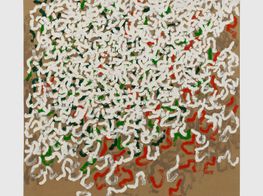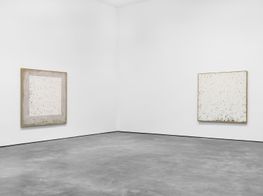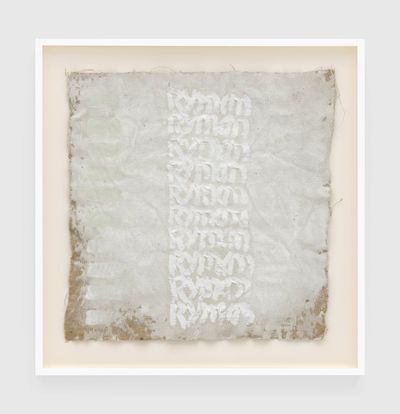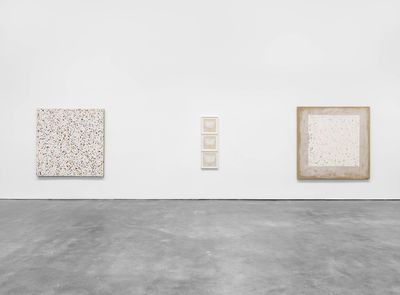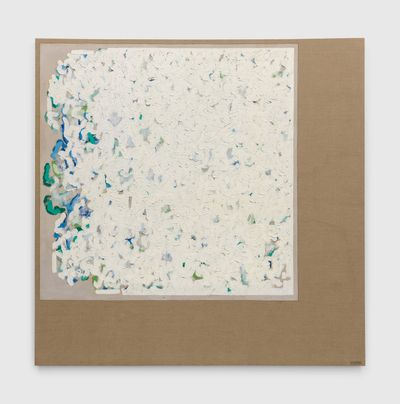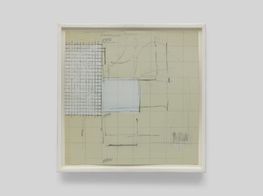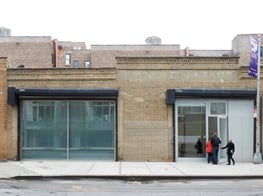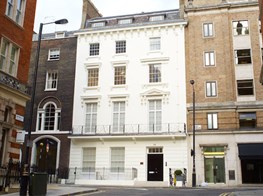
The Quiet Mastery of Robert Ryman
David Zwirner has recently opened two Robert Ryman exhibitions in collaboration with the artist's family. A show of drawings in London, titled Line (30 November 2023–13 January 2024), compliments a major presentation of early paintings from the 1960s, curated by Dieter Schwarz, in New York.
Writing in The Museum of Modern Art (MoMA) catalogue for Ryman's 1993 international survey show, Robert Storr noted that 'seldom has less been said or generally known about the background of a major contemporary painter', reflecting the artist's 'insistence that we focus exclusively on the painting as painting'.
Thirty years on and not a huge amount has changed. In 2017, Phaidon Press published the most comprehensive monograph on Ryman, but there is still comparatively little written on this influential painter. With so little scholarship or mythology, what is it about this painter's painter that gets artists speaking in such revered tones?
It's intriguing that Ryman was so against the idea of his personality distracting from the purity of his practice, especially given that his was a great story. A humble jazz enthusiast, Ryman moved from Nashville, Tennessee, and then toured bases in the South with the Army Reserve Corps. Eventually, in the early 1950s, he relocated to New York, where he taught himself to paint while working as a guard at MoMA. He was to befriend two other fellow employees at the museum between 1959 and 1960 by the names of Dan Flavin and Sol LeWitt.
Camaraderie among his artist peers and a scholarly appreciation of painting were the bedrock of Ryman's existence from his early days living and working in New York. His appreciation of Henri Matisse not only elucidates this but also underpins much of his own approach to painting.
'[Matisse] managed to get at problems and solve them in a very straightforward and clear way,' Ryman gleaned, in discussion with Grace Glueck in 1977. 'Then there was his technical mastery, the way he could handle paint. When he worked, there was no fussing around. He was always direct. There was a sureness about what he did.'
This chess game mentality is inherent to Ryman's practice.
'He has so many moves,' points out artist Anton Munar. 'The more you dig into his practice the more holistic it starts to feel. It's a true investigation through his own desires into what painting can do. There's a tenderness but a roughness. Like a Miles Davis solo, it goes to places where it's allowed to break.'
In Storr's description of Ryman's studio, there is a wall covered in approximately 300 black-and-white photographic images of his paintings, which serve as an ever-evolving reference point for his nuanced body of work.
The MoMA catalogue contains forensic notes from Ryman on nearly every painting from the exhibition, detailing materials used and methods applied. This meticulous attention to process was carried through to his approach to hanging works on the wall with respect to the formal qualities of the object itself and also its interaction with light.
As artist Mary Ramsden remarks, 'I often think about Robert Ryman when I need the light to hit the paint a certain way or I'm messing around with the boundary of a work.'
The legendary The New Yorker critic, Peter Schjeldahl, has also alluded to how 'Ryman invites contemplation of the light that falls on his paintings and of their formal relation to the rooms that contain them'. Schjeldahl even referred to Dia Art Foundation's 2015 exhibition on Ryman as a 'spiritual time capsule' but questioned whether 'there will be an audience eager to put up with it' in this age of instant gratification.
I hope painters whose work rewards time spent with it will continue to be appreciated. Judging by recent auction results, there are other optimists out there too. In 2022, Ryman's 1961 painting fetched US $20.1 million when The Collection of Thomas and Doris Ammann was sold at Christie's in New York. The recent result of US $18.7 million for an Agnes Martin painting from the same year provides further hope for some longevity for these artists who eschewed the machismo of gestural abstract expressionism for a more subtle approach.
Ryman's art lives on fervently in the minds of artists painting today and it's touching to hear the impact he has on their daily joust with the canvas. Swiss painter Raphael Egil credits Ryman with 'forcing [him] to find out something about the potential of painting', while Munar admits that '[Ryman] will always be on my mind, someone you can always learn from.'
'It's very fetishistic,' he continues. 'If you love painting then you love Ryman. His work is mystical and almost religious in its devotion to painting.'
As long as artists and curators retain this level of adoration for Ryman's work, it's hard to see his legacy being diminished in the years to come.
Main image: Exhibition view: Robert Ryman, Robert Ryman: 1961–1964, David Zwirner, New York (9 November 2023–3 February 2024). Courtesy David Zwirner, New York.

